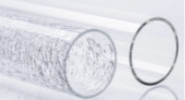
Air freshener for old buildings
Say goodbye to bad smells
Corked wine and musty rooms. Both are unpleasant and both often have the same cause. The wood preservatives used in impregnated pallets and the wooden beams of old houses can release gases that cause moldy smelling aerosols to appear – the same molecules that accumulate on corks to give a once delicious wine that feared corked taste.Help comes in the form of photocatalysis – a process that decomposes undesirable gases using UV radiation and a catalyst. However, existing solutions have their drawbacks: “The present technology is neither very efficient nor particularly sustainable,” explains Andreas Beck, Managing Director of Triplan Umwelttechnik.
From contaminant to CO2
Beck and his team of engineers have developed the TRIPLAN LightClean® ventilation solution, which uses glass instead of paper as the carrier for the catalyst. The device, a simple, stainless steel column with a built-in ventilator, first sucks up the polluted air in the room. “The contaminant molecules accumulate inside TRIPLAN LightClean® on a panel consisting of small glass tubes measuring about six inches in length,” says Beck.The individual glass tubes are coated with a semiconductor material using a specially developed process. When stimulated by UV light, cold combustion converts the contaminants into carbon dioxide and water. TRIPLAN LightClean® then releases the clean air back into the room.
Engineers at Triplan Umwelttechnik have developed innovative photocatalytic ventilation systems that achieve a high level of efficiency. Special glass from SCHOTT is used as an ideal catalyst carrier.
The sustainable solution
To achieve this reaction, the Harburg-based company uses DURAN® borosilicate glass tubing from SCHOTT. This specialty glass offers a number of key advantages that make it an ideal catalyst carrier. “It has a much higher level of efficiency than any other material,” says Beck.“Because of the high transparency of the DURAN® glass tubing, the UV light can penetrate deep into the reactor and reach a much larger activation surface using the same amount of energy,” explains Dietmar Katlun, Area Sales Manager at SCHOTT Technical Tubing. This also makes TRIPLAN LightClean® highly sustainable.
From old buildings to wine
The idea for an air-cleaning system for old buildings came about more by chance than by design. “We originally wanted to develop a way to clean toxic exhaust air in laboratories,” explains Beck. Photocatalysis turned out to be too weak for high concentrations of toxic contaminants. “But we discovered that it worked exceptionally well with lower concentrations like those that are common in prefabricated houses and old buildings,” adds Beck.The system is not only effective against the chloroanisoles that cause corked wine, but also against formaldehyde (often used to glue together particle board and laminate) and ozone (produced by old printers). All of this would not have been possible without the help of SCHOTT. “Mr. Katlun and his colleagues did not just supply a product, they also supported us with their technical expertise,” states Beck.
Prototypes of TRIPLAN LightClean® are currently in progress. “French winemakers and the old building renovation sector have already recognized the potential”, says Beck. Over 30 large devices have already been delivered to wine cellars in France. “The first customers are all extremely happy with the performance of the devices, particularly regarding the reduction of chloroanisole odor,” assures Beck.
In addition to stale old buildings and corked wine, the Managing Director sees further uses for the system. “Fresh, clean air is also an advantage in medical practices, and we have received enquiries for managing odors at workstations, such as acetic acid.”
DURAN® is a registered trademark of the DWK Life Sciences GmbH.
Used materials & similar products
Invented by Otto Schott in 1897, DURAN® borosilicate glass is known for its high temperature resistance and optical brilliance, as well as its tight geometrical tolerances. The glass is highly versatile and found in a wide range of applications from industrial and laboratory glassware to architecture and interior design. Available in a vast range of shapes and dimensions, the glass can also be treated with an anti-reflection and anti-fingerprint coating, resulting in a long-lasting and highly durable material.






